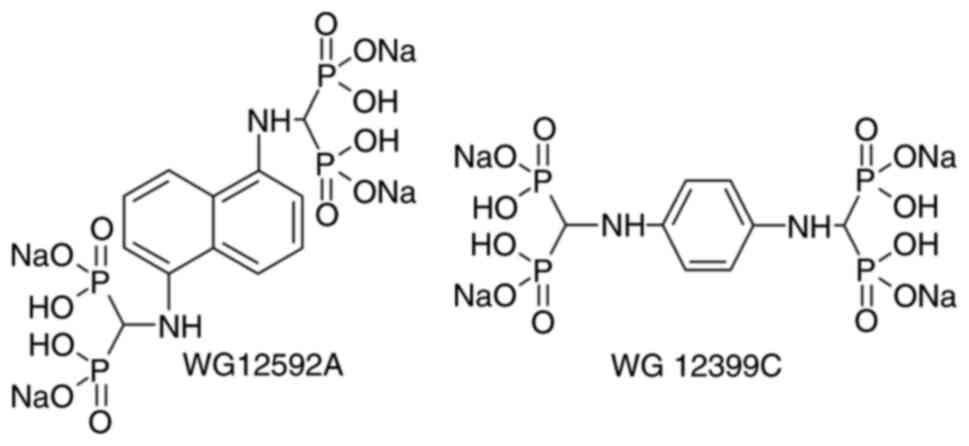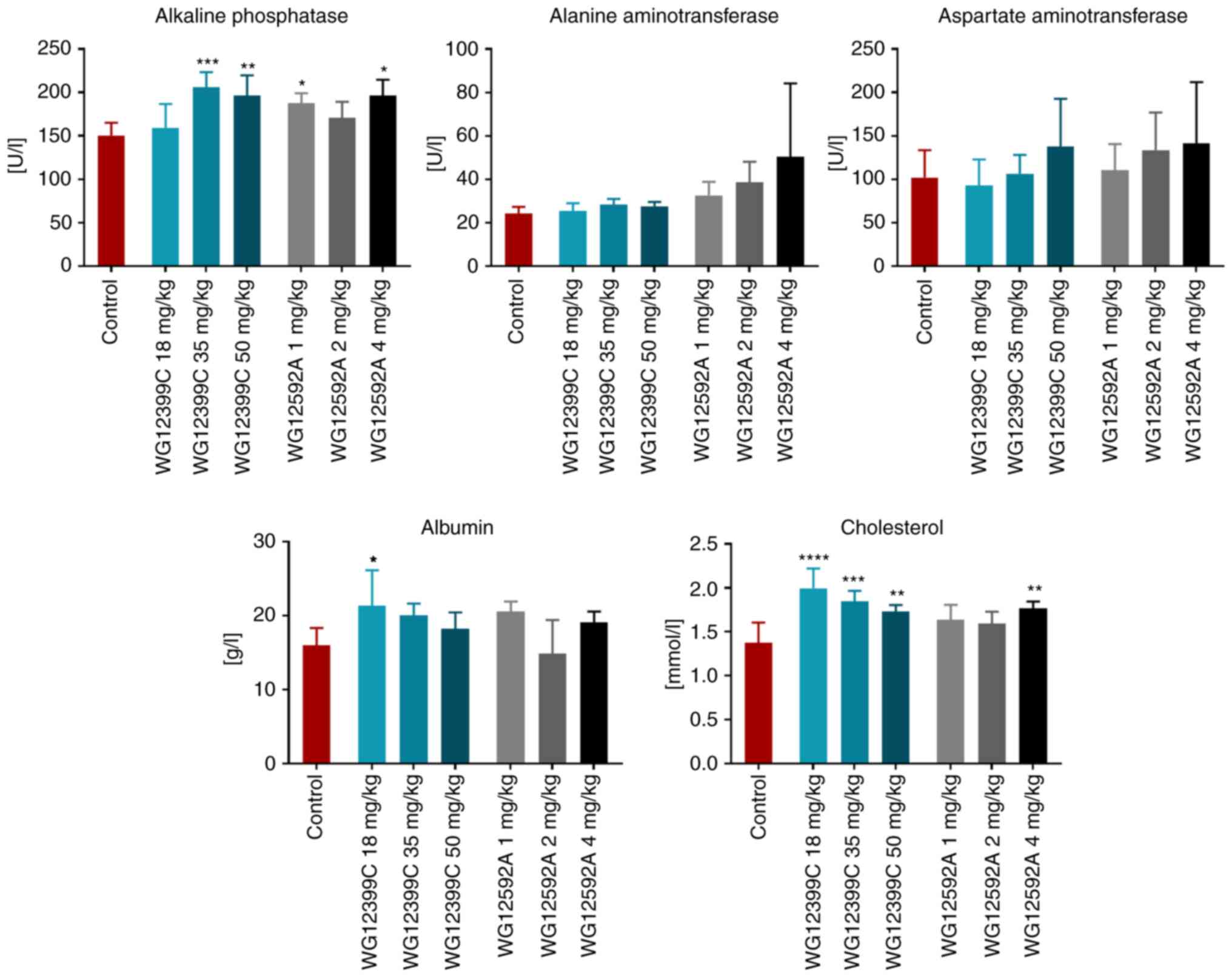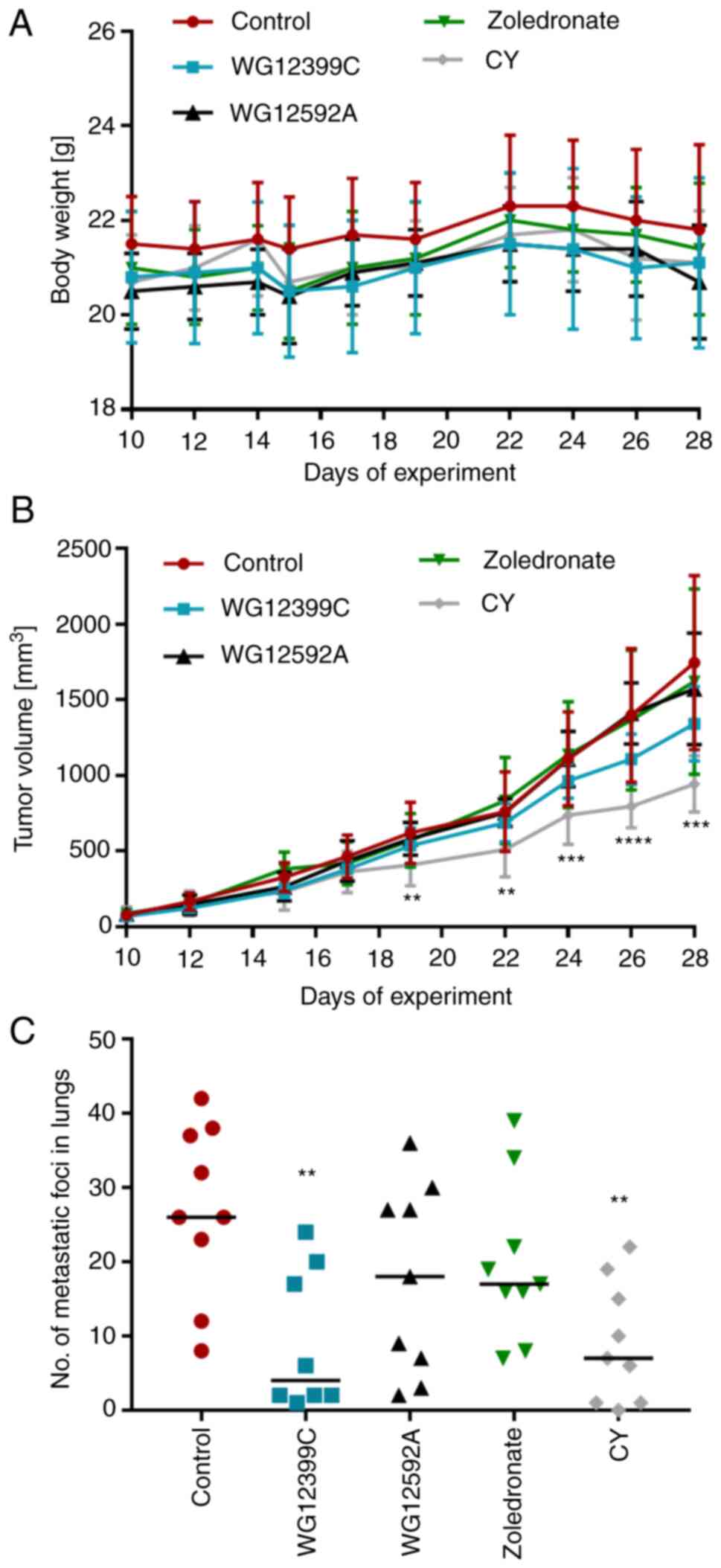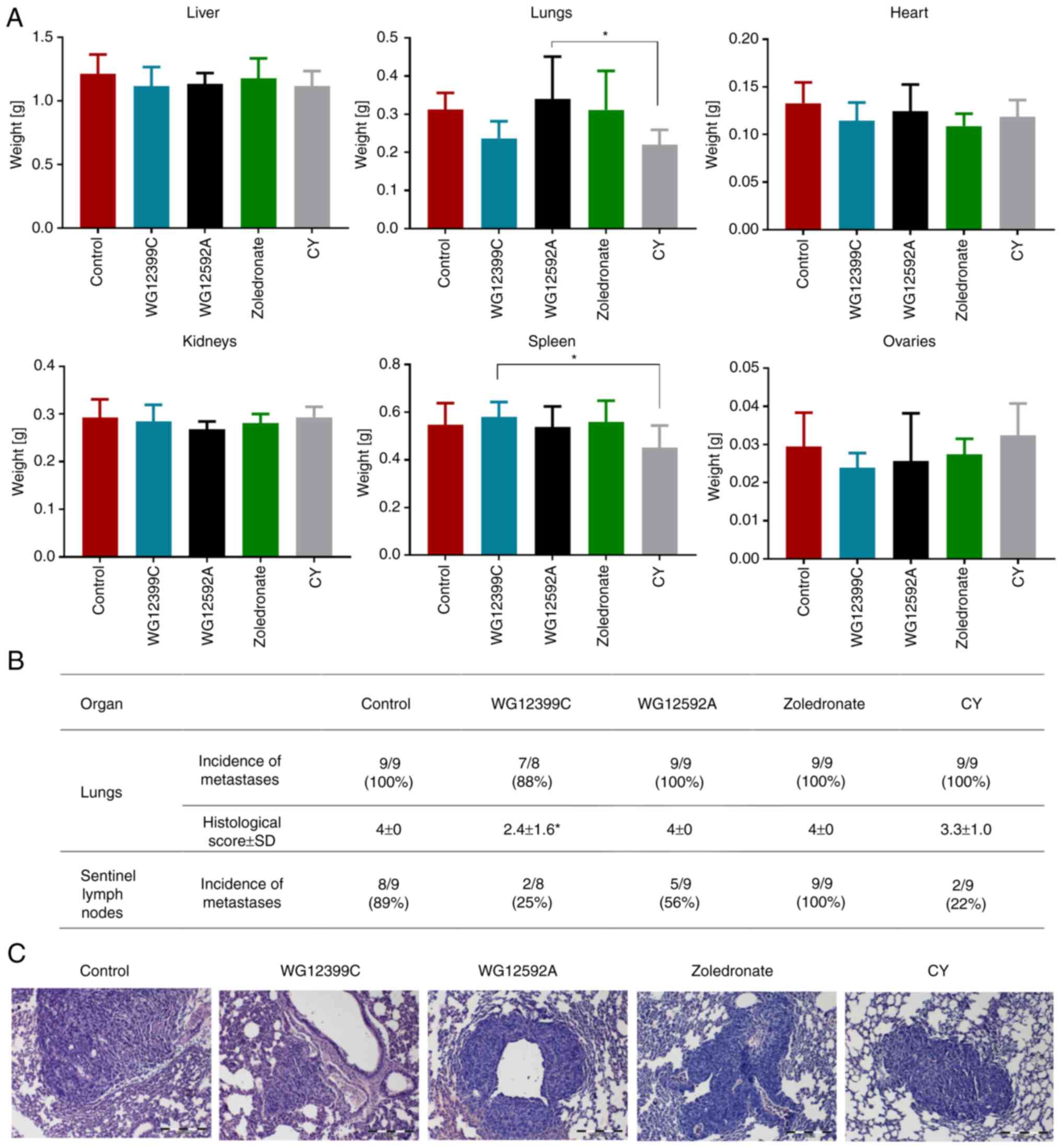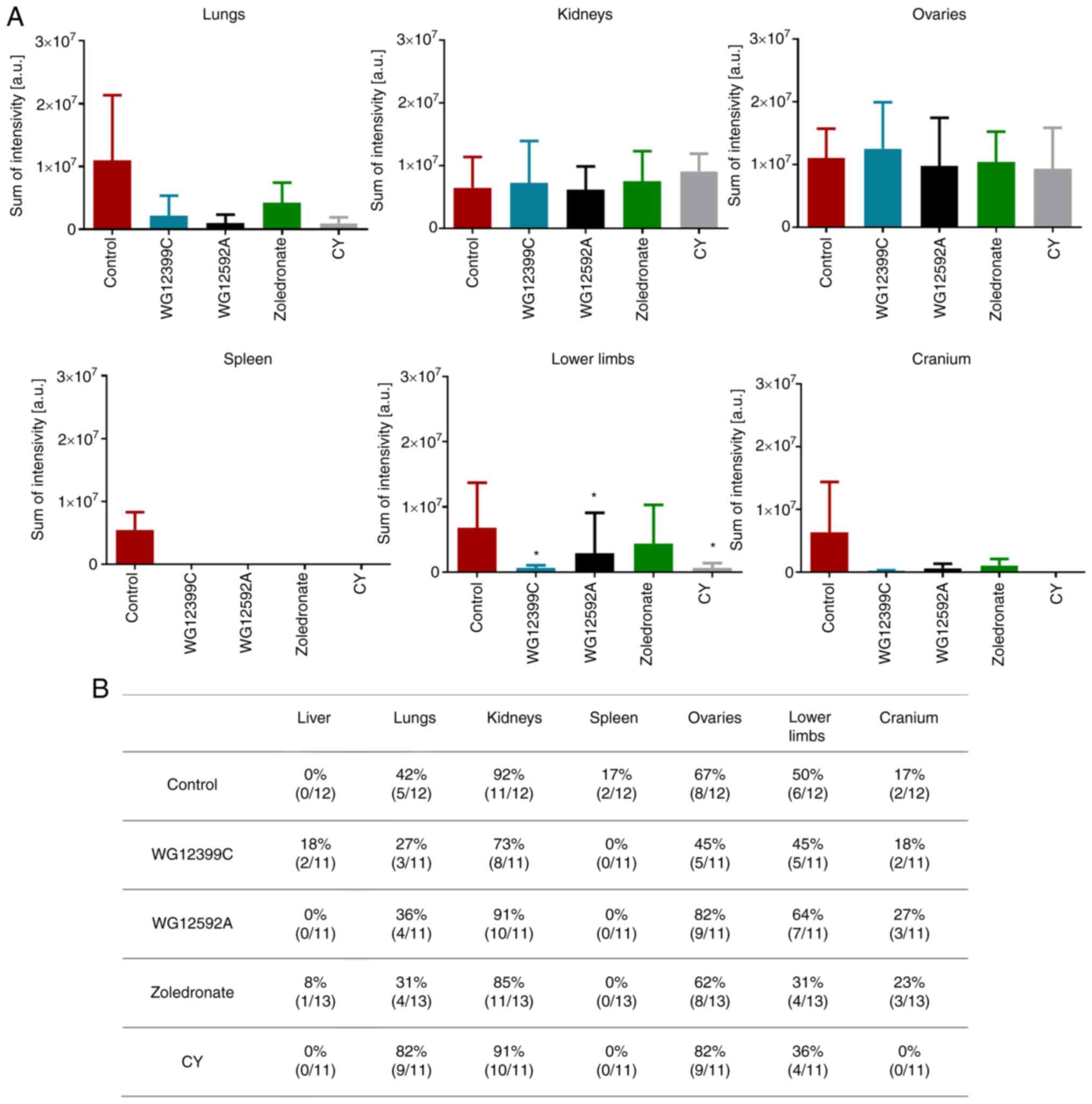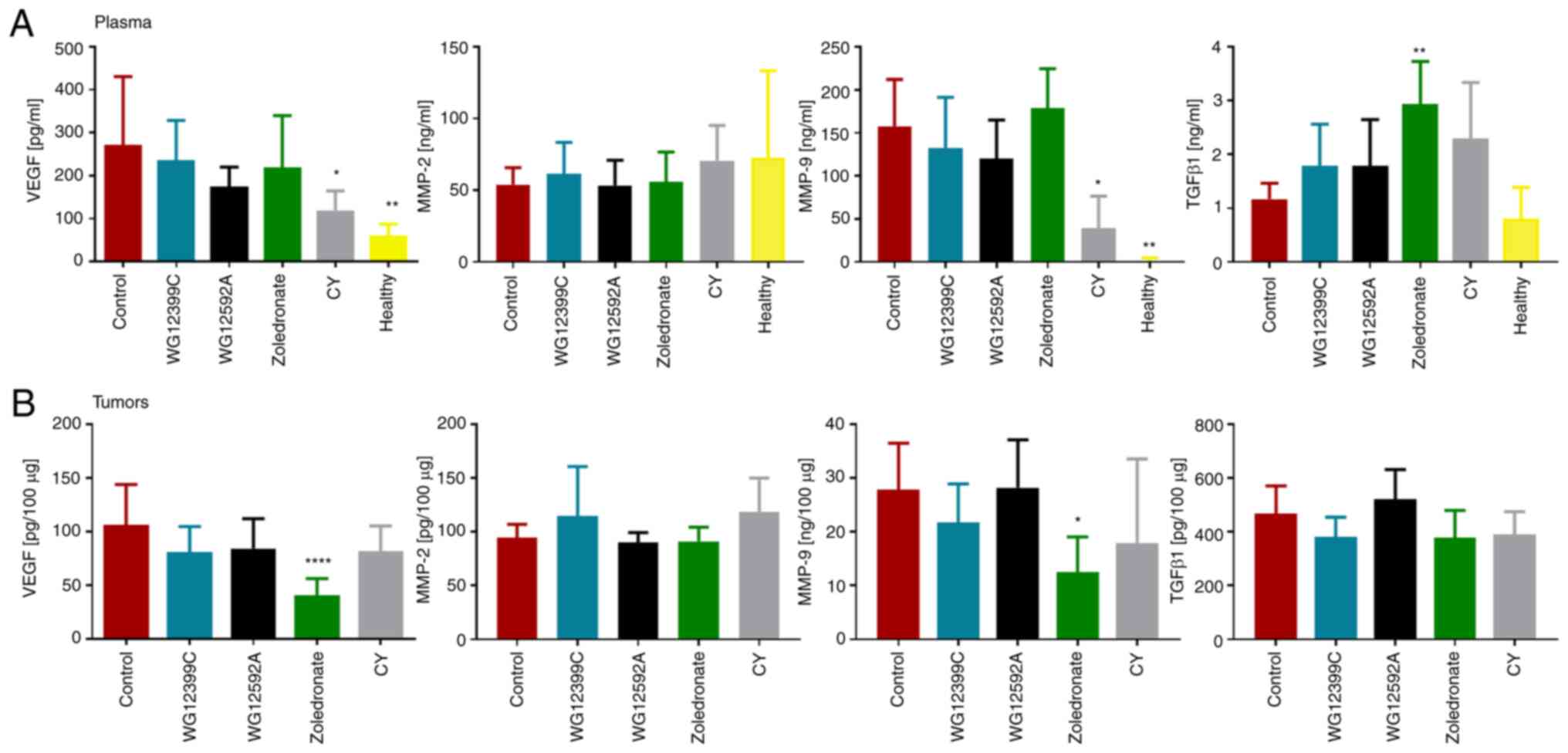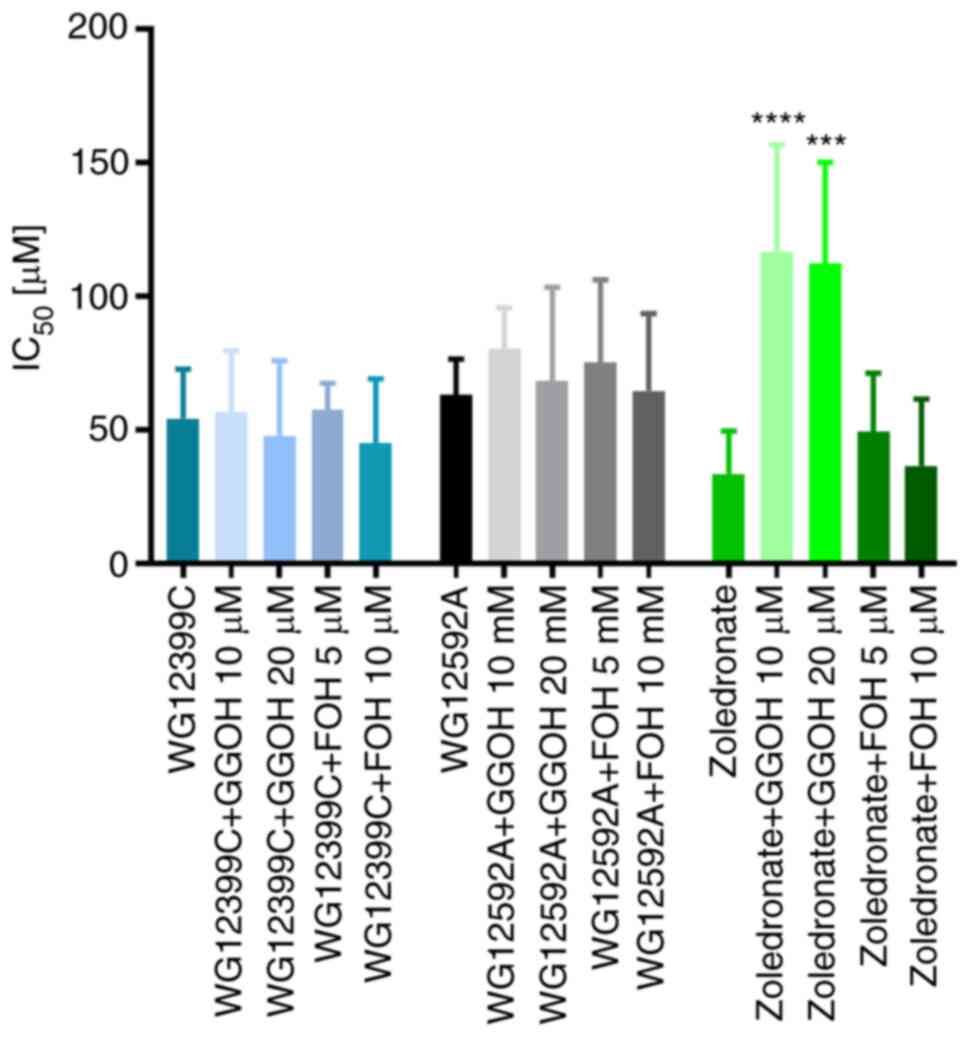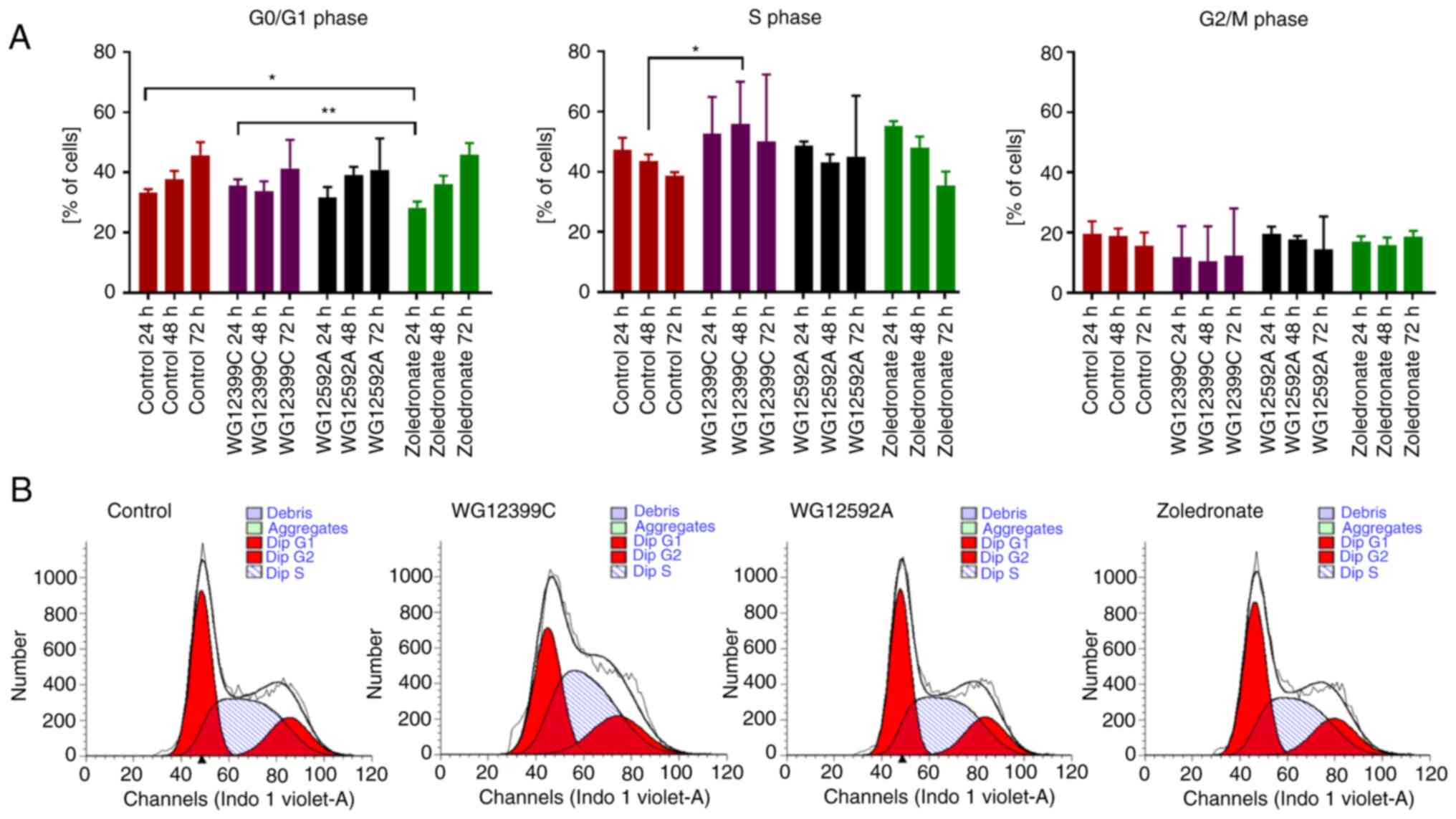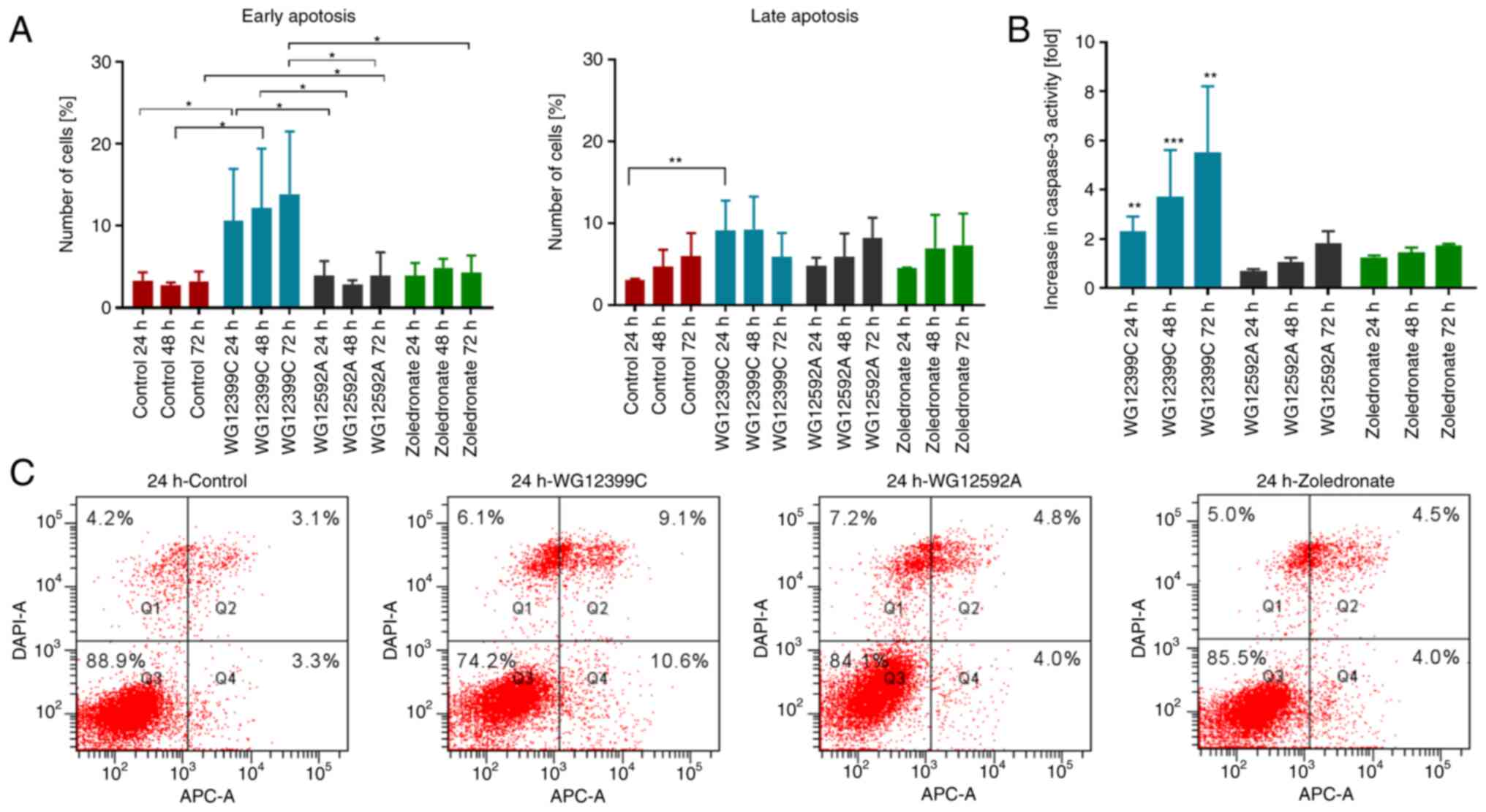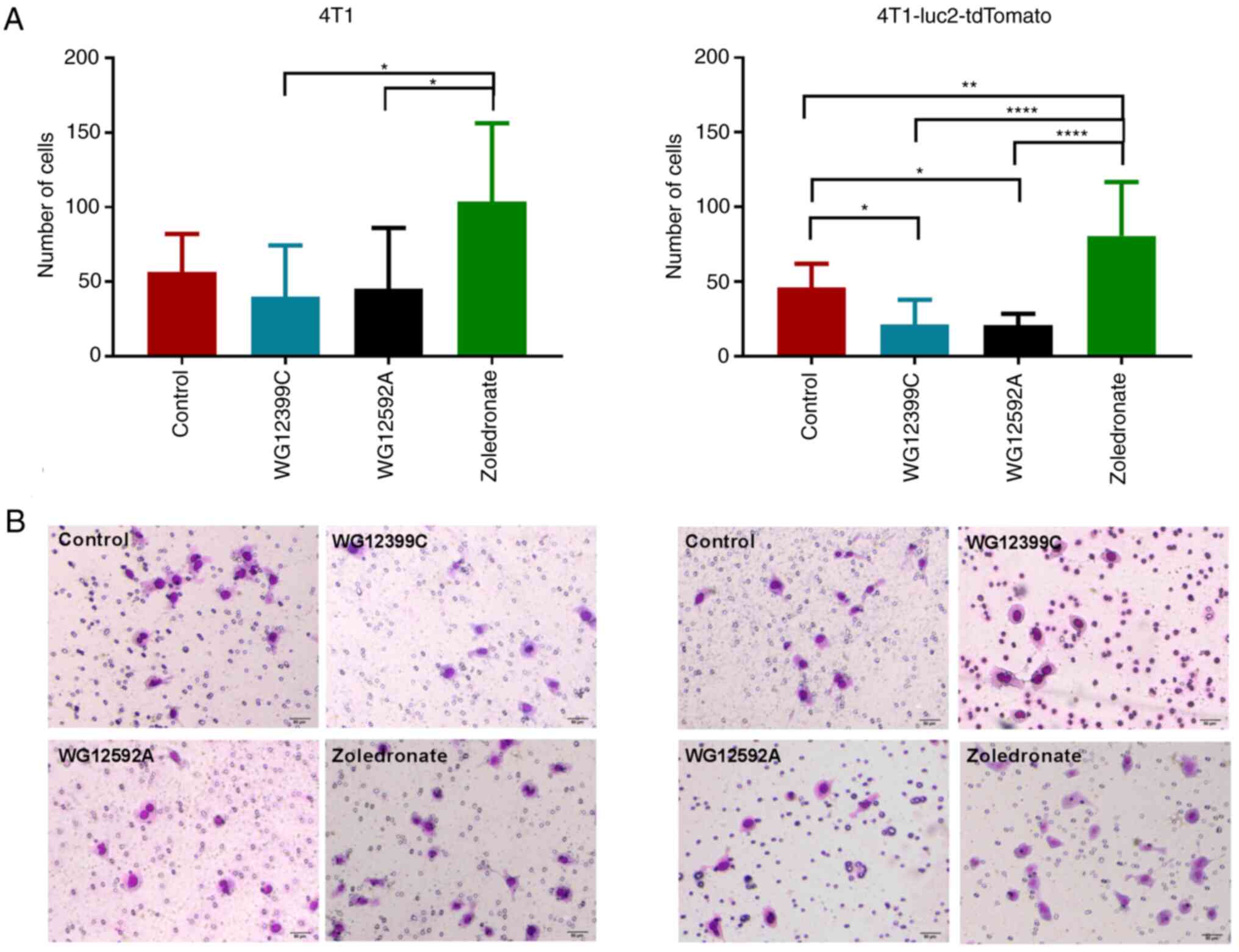|
1
|
Breast cancer. https://www.who.int/news-room/fact-sheets/detail/breast-cancer
|
|
2
|
Siegel RL, Miller KD and Jemal A: Cancer
statistics, 2020. CA Cancer J Clin. 70:7–30. 2020. View Article : Google Scholar : PubMed/NCBI
|
|
3
|
Gainford MC, Dranitsaris G and Clemons M:
Recent developments in bisphosphonates for patients with metastatic
breast cancer. BMJ. 330:769–773. 2005. View Article : Google Scholar : PubMed/NCBI
|
|
4
|
Coleman RE: Clinical features of
metastatic bone disease and risk of skeletal morbidity. Clin Cancer
Res. 12:6243s–6249s. 2006. View Article : Google Scholar : PubMed/NCBI
|
|
5
|
D'Oronzo S, Wood S and Brown JE: The use
of bisphosphonates to treat skeletal complications in solid
tumours. Bone. 147:1159072021. View Article : Google Scholar : PubMed/NCBI
|
|
6
|
Goldvaser H and Amir E: Role of
bisphosphonates in breast cancer therapy. Curr Treat Options Oncol.
20:262019. View Article : Google Scholar : PubMed/NCBI
|
|
7
|
Boissier S, Ferreras M, Peyruchaud O,
Magnetto S, Ebetino FH, Colombel M, Delmas P, Delaissé JM and
Clézardin P: Bisphosphonates inhibit breast and prostate carcinoma
cell invasion, an early event in the formation of bone metastases.
Cancer Res. 60:2949–2954. 2000.PubMed/NCBI
|
|
8
|
Senaratne SG, Pirianov G, Mansi JL, Arnett
TR and Colston KW: Bisphosphonates induce apoptosis in human breast
cancer cell lines. Br J Cancer. 82:1459–1468. 2000. View Article : Google Scholar : PubMed/NCBI
|
|
9
|
Buranrat B and Bootha S: Antiproliferative
and antimigratory activities of bisphosphonates in human breast
cancer cell line MCF-7. Oncol Lett. 18:1246–1258. 2019.PubMed/NCBI
|
|
10
|
Misso G, Porru M, Stoppacciaro A,
Castellano M, De Cicco F, Leonetti C, Santini D and Caraglia M:
Evaluation of the in vitro and in vivo antiangiogenic effects of
denosumab and zoledronic acid. Cancer Biol Ther. 13:1491–1500.
2012. View Article : Google Scholar : PubMed/NCBI
|
|
11
|
Tanaka Y, Iwasaki M, Murata-Hirai K,
Matsumoto K, Hayashi K, Okamura H, Sugie T, Minato N, Morita CT and
Toi M: Anti-tumor activity and immunotherapeutic potential of a
bisphosphonate prodrug. Sci Rep. 7:59872017. View Article : Google Scholar : PubMed/NCBI
|
|
12
|
Dhesy-Thind S, Fletcher GG, Blanchette PS,
Clemons MJ, Dillmon MS, Frank ES, Gandhi S, Gupta R, Mates M, Moy
B, et al: Use of adjuvant bisphosphonates and other bone-modifying
agents in breast cancer: A cancer care Ontario and American society
of clinical oncology clinical practice guideline. J Clin Oncol.
35:2062–2081. 2017. View Article : Google Scholar : PubMed/NCBI
|
|
13
|
Cardoso F, Kyriakides S, Ohno S,
Penault-Llorca F, Poortmans P, Rubio IT, Zackrisson S and Senkus E;
ESMO Guidelines Committee. Electronic address, : simpleclinicalguidelines@esmo.org:
Early breast cancer: ESMO clinical practice guidelines for
diagnosis, treatment and follow-up†. Ann Oncol. 30:1194–1220. 2019.
View Article : Google Scholar : PubMed/NCBI
|
|
14
|
Goldeman W, Kluczyński A and Soroka M: The
preparation of N-substituted aminomethylidenebisphosphonates and
their tetraalkyl esters via reaction of isonitriles with trialkyl
phosphites and hydrogen chloride. Part 1. Tetrahedron Lett.
53:5290–5292. 2012. View Article : Google Scholar
|
|
15
|
Goldeman W and Nasulewicz-Goldeman A:
Synthesis and antiproliferative activity of aromatic and aliphatic
bis[aminomethylidene(bisphosphonic)] acids. Bioorg Med Chem Lett.
24:3475–3479. 2014. View Article : Google Scholar : PubMed/NCBI
|
|
16
|
Nasulewicz-Goldeman A, Goldeman W,
Mrówczyńska E and Wietrzyk J: Biological effects of aromatic
bis[aminomethylidenebis(phosphonic)] acids in osteoclast precursors
in vitro. Chem Biol Drug Des. 94:1835–1848. 2019. View Article : Google Scholar : PubMed/NCBI
|
|
17
|
Nasulewicz-Goldeman A, Goldeman W, Nikodem
A, Nowak M, Papiernik D, Goszczyński TM and Wietrzyk J: Aromatic
bis[aminomethylidenebis(phosphonic)] acids prevent
ovariectomy-induced bone loss and suppress osteoclastogenesis in
mice. Int J Mol Sci. 22:95902021. View Article : Google Scholar : PubMed/NCBI
|
|
18
|
Singh SK, Manne N, Ray PC and Pal M:
Synthesis of imidazol-1-yl-acetic acid hydrochloride: A key
intermediate for zoledronic acid. Beilstein J Org Chem. 4:422008.
View Article : Google Scholar : PubMed/NCBI
|
|
19
|
Balathasan L, Beech JS and Muschel RJ:
Ultrasonography-guided intracardiac injection: An improvement for
quantitative brain colonization assays. Am J Pathol. 183:26–34.
2013. View Article : Google Scholar : PubMed/NCBI
|
|
20
|
Hiraga T, Williams PJ, Ueda A, Tamura D
and Yoneda T: Zoledronic acid inhibits visceral metastases in the
4T1/luc mouse breast cancer model. Clin Cancer Res. 10:4559–4567.
2004. View Article : Google Scholar : PubMed/NCBI
|
|
21
|
Blazejczyk A, Switalska M, Chlopicki S,
Marcinek A, Gebicki J, Nowak M, Nasulewicz-Goldeman A and Wietrzyk
J: 1-methylnicotinamide and its structural analog
1,4-dimethylpyridine for the prevention of cancer metastasis. J Exp
Clin Cancer Res. 35:1102016. View Article : Google Scholar : PubMed/NCBI
|
|
22
|
Skehan P, Storeng R, Scudiero D, Monks A,
McMahon J, Vistica D, Warren JT, Bokesch H, Kenney S and Boyd MR:
New colorimetric cytotoxicity assay for anticancer-drug screening.
J Natl Cancer Inst. 82:1107–1112. 1990. View Article : Google Scholar : PubMed/NCBI
|
|
23
|
Chou TC and Talalay P: Generalized
equations for the analysis of inhibitions of Michaelis-Menten and
higher-order kinetic systems with two or more mutually exclusive
and nonexclusive inhibitors. Eur J Biochem. 115:207–216. 1981.
View Article : Google Scholar : PubMed/NCBI
|
|
24
|
Chou TC and Talalay P: Quantitative
analysis of dose-effect relationships: The combined effects of
multiple drugs or enzyme inhibitors. Adv Enzyme Regul. 22:27–55.
1984. View Article : Google Scholar : PubMed/NCBI
|
|
25
|
Features T and Information G: Bioware
ultra cell line NCI-H460-luc2. 2–3. 2010.http://www.caliperls.com/assets/027/8876.pdf
|
|
26
|
Zhang Z, Hu Z, Gupta J, Krimmel JD,
Gerseny HM, Berg AF, Robbins JS, Du H, Prabhakar B and Seth P:
Intravenous administration of adenoviruses targeting transforming
growth factor beta signaling inhibits established bone metastases
in 4T1 mouse mammary tumor model in an immunocompetent syngeneic
host. Cancer Gene Ther. 19:630–636. 2012. View Article : Google Scholar : PubMed/NCBI
|
|
27
|
Campbell JP, Merkel AR, Masood-Campbell
SK, Elefteriou F and Sterling JA: Models of bone metastasis. J Vis
Exp. e42602012.PubMed/NCBI
|
|
28
|
Werbeck JL, Thudi NK, Martin CK,
Premanandan C, Yu L, Ostrowksi MC and Rosol TJ: Tumor
microenvironment regulates metastasis and metastasis genes of mouse
MMTV-PymT mammary cancer cells in vivo. Vet Pathol. 51:868–881.
2014. View Article : Google Scholar : PubMed/NCBI
|
|
29
|
Zhou Z, Qutaish M, Han Z, Schur RM, Liu Y,
Wilson DL and Lu ZR: MRI detection of breast cancer micrometastases
with a fibronectin-targeting contrast agent. Nat Commun.
6:79842015. View Article : Google Scholar : PubMed/NCBI
|
|
30
|
Denoyelle C, Hong L, Vannier JP, Soria J
and Soria C: New insights into the actions of bisphosphonate
zoledronic acid in breast cancer cells by dual RhoA-dependent and
-independent effects. Br J Cancer. 88:1631–1640. 2003. View Article : Google Scholar : PubMed/NCBI
|
|
31
|
Goffinet M, Thoulouzan M, Pradines A,
Lajoie-Mazenc I, Weinbaum C, Faye JC and Séronie-Vivien S:
Zoledronic acid treatment impairs protein geranyl-geranylation for
biological effects in prostatic cells. BMC Cancer. 6:602006.
View Article : Google Scholar : PubMed/NCBI
|
|
32
|
Iguchi T, Miyakawa Y, Yamamoto K, Kizaki M
and Ikeda Y: Nitrogen-containing bisphosphonates induce S-phase
cell cycle arrest and apoptosis of myeloma cells by activating MAPK
pathway and inhibiting mevalonate pathway. Cell Signal. 15:719–727.
2003. View Article : Google Scholar : PubMed/NCBI
|
|
33
|
Okamoto S, Jiang Y, Kawamura K, Shingyoji
M, Tada Y, Sekine I, Takiguchi Y, Tatsumi K, Kobayashi H, Shimada
H, et al: Zoledronic acid induces apoptosis and S-phase arrest in
mesothelioma through inhibiting Rab family proteins and
topoisomerase II actions. Cell Death Dis. 5:e15172014. View Article : Google Scholar : PubMed/NCBI
|
|
34
|
Diel IJ, Solomayer EF, Costa SD, Gollan C,
Goerner R, Wallwiener D, Kaufmann M and Bastert G: Reduction in new
metastases in breast cancer with adjuvant clodronate treatment. N
Engl J Med. 339:357–363. 1998. View Article : Google Scholar : PubMed/NCBI
|
|
35
|
Saarto T, Blomqvist C, Virkkunen P and
Elomaa I: Adjuvant clodronate treatment does not reduce the
frequency of skeletal metastases in node-positive breast cancer
patients: 5-Year results of a randomized controlled trial. J Clin
Oncol. 19:10–17. 2001. View Article : Google Scholar : PubMed/NCBI
|
|
36
|
Kohno N, Aogi K, Minami H, Nakamura S,
Asaga T, Iino Y, Watanabe T, Goessl C, Ohashi Y and Takashima S:
Zoledronic acid significantly reduces skeletal complications
compared with placebo in Japanese women with bone metastases from
breast cancer: A randomized, placebo-controlled trial. J Clin
Oncol. 23:3314–3321. 2005. View Article : Google Scholar : PubMed/NCBI
|
|
37
|
Lawson MA, Xia Z, Barnett BL, Triffitt JT,
Phipps RJ, Dunford JE, Locklin RM, Ebetino FH and Russell RG:
Differences between bisphosphonates in binding affinities for
hydroxyapatite. J Biomed Mater Res B Appl Biomater. 92:149–155.
2010. View Article : Google Scholar : PubMed/NCBI
|
|
38
|
Hortobagyi GN, Theriault RL, Porter L,
Blayney D, Lipton A, Sinoff C, Wheeler H, Simeone JF, Seaman J and
Knight RD: Efficacy of pamidronate in reducing skeletal
complications in patients with breast cancer and lytic bone
metastases. Protocol 19 aredia breast cancer study group. N Engl J
Med. 335:1785–1792. 1996. View Article : Google Scholar : PubMed/NCBI
|
|
39
|
Steinman RA, Brufsky AM and Oesterreich S:
Zoledronic acid effectiveness against breast cancer metastases-a
role for estrogen in the microenvironment? Breast Cancer Res.
14:2132012. View Article : Google Scholar : PubMed/NCBI
|
|
40
|
Farhoodi HP, Segaliny AI, Wagoner ZW,
Cheng JL, Liu L and Zhao W: Optimization of a syngeneic murine
model of bone metastasis. J Bone Oncol. 23:1002982020. View Article : Google Scholar : PubMed/NCBI
|
|
41
|
Michigami T, Hiraga T, Williams PJ,
Niewolna M, Nishimura R, Mundy GR and Yoneda T: The effect of the
bisphosphonate ibandronate on breast cancer metastasis to visceral
organs. Breast Cancer Res Treat. 75:249–258. 2002. View Article : Google Scholar : PubMed/NCBI
|
|
42
|
Ottewell PD, Mönkkönen H, Jones M, Lefley
DV, Coleman RE and Holen I: Antitumor effects of doxorubicin
followed by zoledronic acid in a mouse model of breast cancer. J
Natl Cancer Inst. 100:1167–1178. 2008. View Article : Google Scholar : PubMed/NCBI
|
|
43
|
Santini D, Vincenzi B, Dicuonzo G,
Avvisati G, Massacesi C, Battistoni F, Gavasci M, Rocci L,
Tirindelli MC, Altomare V, et al: Zoledronic acid induces
significant and long-lasting modifications of circulating
angiogenic factors in cancer patients. Clin Cancer Res.
9:2893–2897. 2003.PubMed/NCBI
|
|
44
|
Bellone F, Catalano A, Sottile AR, Gaudio
A, Loddo S, Corica F and Morabito N: Early Changes of VEGF levels
after zoledronic acid in women with postmenopausal osteoporosis: A
potential role of vitamin D. Front Med (Lausanne). 8:7484382021.
View Article : Google Scholar : PubMed/NCBI
|
|
45
|
Luckman SP, Hughes DE, Coxon FP, Graham R,
Russell G and Rogers MJ: Nitrogen-containing bisphosphonates
inhibit the mevalonate pathway and prevent post-translational
prenylation of GTP-binding proteins, including ras. J Bone Miner
Res. 13:581–589. 1998. View Article : Google Scholar : PubMed/NCBI
|
|
46
|
Benford HL, Frith JC, Auriola S, Mönkkönen
J and Rogers MJ: Farnesol and geranylgeraniol prevent activation of
caspases by aminobisphosphonates: Biochemical evidence for two
distinct pharmacological classes of bisphosphonate drugs. Mol
Pharmacol. 56:131–140. 1999. View Article : Google Scholar : PubMed/NCBI
|
|
47
|
Russell RGG, Watts NB, Ebetino FH and
Rogers MJ: Mechanisms of action of bisphosphonates: Similarities
and differences and their potential influence on clinical efficacy.
Osteoporos Int. 19:733–759. 2008. View Article : Google Scholar : PubMed/NCBI
|
|
48
|
Suyama K, Noguchi Y, Tanaka T, Yoshida T,
Shibata T, Saito Y and Tatsuno I: Isoprenoid-independent pathway is
involved in apoptosis induced by risedronate, a bisphosphonate, in
which Bim plays a critical role in breast cancer cell line MCF-7.
Oncol Rep. 18:1291–1298. 2007.PubMed/NCBI
|
|
49
|
Miwa A, Takezako N, Hayakawa H, Hayakawa
M, Tominaga S and Yanagisawa K: YM-175 induces apoptosis of human
native monocyte-lineage cells via inhibition of prenylation. Am J
Hematol. 87:1084–1088. 2012. View Article : Google Scholar : PubMed/NCBI
|
|
50
|
Benassi MS, Chiechi A, Ponticelli F,
Pazzaglia L, Gamberi G, Zanella L, Manara MC, Perego P, Ferrari S
and Picci P: Growth inhibition and sensitization to cisplatin by
zoledronic acid in osteosarcoma cells. Cancer Lett. 250:194–205.
2007. View Article : Google Scholar : PubMed/NCBI
|
|
51
|
Matsumoto S, Kimura S, Segawa H, Kuroda J,
Yuasa T, Sato K, Nogawa M, Tanaka F, Maekawa T and Wada H: Efficacy
of the third-generation bisphosphonate, zoledronic acid alone and
combined with anti-cancer agents against small cell lung cancer
cell lines. Lung Cancer. 47:31–39. 2005. View Article : Google Scholar : PubMed/NCBI
|
|
52
|
Koto K, Murata H, Kimura S, Horie N,
Matsui T, Nishigaki Y, Ryu K, Sakabe T, Itoi M, Ashihara E, et al:
Zoledronic acid inhibits proliferation of human fibrosarcoma cells
with induction of apoptosis, and shows combined effects with other
anticancer agents. Oncol Rep. 24:233–239. 2010.PubMed/NCBI
|
|
53
|
Ottewell PD, Deux B, Mönkkb̈nen H, Cross
S, Coleman RE, Clezardin P and Holen I: Differential effect of
doxorubicin and zoledronic acid on intraosseous versus extraosseous
breast tumor growth in vivo. Clin Cancer Res. 14:4658–4666. 2008.
View Article : Google Scholar : PubMed/NCBI
|
|
54
|
Van Beek ER, Lowik CWGM, Van Wijngaarden
J, Ebetino FH and Papapoulos SE: Synergistic effect of
bisphosphonate and docetaxel on the growth of bone metastasis in an
animal model of established metastatic bone disease. Breast Cancer
Res Treat. 118:307–313. 2009. View Article : Google Scholar : PubMed/NCBI
|
|
55
|
Zhao Z, Shen W, Zhu H, Lin L, Jiang G, Zhu
Y, Song H and Wu L: Zoledronate inhibits fibroblasts' proliferation
and activation via targeting TGF-β signaling pathway. Drug Des
Devel Ther. 12:3021–3031. 2018. View Article : Google Scholar : PubMed/NCBI
|
|
56
|
Wang L, Liu Y, Zhou Y, Wang J, Tu L, Sun
Z, Wang X and Luo F: Zoledronic acid inhibits the growth of cancer
stem cell derived from cervical cancer cell by attenuating their
stemness phenotype and inducing apoptosis and cell cycle arrest
through the Erk1/2 and Akt pathways. J Exp Clin Cancer Res.
38:932019. View Article : Google Scholar : PubMed/NCBI
|















